[English] 日本語
 Yorodumi
Yorodumi- PDB-6lni: Cryo-EM structure of amyloid fibril formed by full-length human p... -
+ Open data
Open data
- Basic information
Basic information
| Entry | Database: PDB / ID: 6lni | ||||||
|---|---|---|---|---|---|---|---|
| Title | Cryo-EM structure of amyloid fibril formed by full-length human prion protein | ||||||
 Components Components | Major prion protein | ||||||
 Keywords Keywords | PROTEIN FIBRIL / Amyloid fibril | ||||||
| Function / homology |  Function and homology information Function and homology informationnegative regulation of amyloid precursor protein catabolic process / regulation of glutamate receptor signaling pathway / lamin binding / aspartic-type endopeptidase inhibitor activity / regulation of calcium ion import across plasma membrane / positive regulation of glutamate receptor signaling pathway / glycosaminoglycan binding / NCAM1 interactions / type 5 metabotropic glutamate receptor binding / ATP-dependent protein binding ...negative regulation of amyloid precursor protein catabolic process / regulation of glutamate receptor signaling pathway / lamin binding / aspartic-type endopeptidase inhibitor activity / regulation of calcium ion import across plasma membrane / positive regulation of glutamate receptor signaling pathway / glycosaminoglycan binding / NCAM1 interactions / type 5 metabotropic glutamate receptor binding / ATP-dependent protein binding / negative regulation of interleukin-17 production / cupric ion binding / regulation of potassium ion transmembrane transport / negative regulation of protein processing / negative regulation of dendritic spine maintenance / dendritic spine maintenance / negative regulation of calcineurin-NFAT signaling cascade / extrinsic component of membrane / negative regulation of interleukin-2 production / Insertion of tail-anchored proteins into the endoplasmic reticulum membrane / negative regulation of T cell receptor signaling pathway / negative regulation of activated T cell proliferation / negative regulation of amyloid-beta formation / response to amyloid-beta / negative regulation of type II interferon production / cuprous ion binding / negative regulation of long-term synaptic potentiation / intracellular copper ion homeostasis / positive regulation of protein targeting to membrane / long-term memory / response to cadmium ion / inclusion body / neuron projection maintenance / positive regulation of calcium-mediated signaling / tubulin binding / molecular function activator activity / cellular response to copper ion / positive regulation of protein localization to plasma membrane / molecular condensate scaffold activity / protein homooligomerization / protein destabilization / cellular response to xenobiotic stimulus / cellular response to amyloid-beta / terminal bouton / positive regulation of neuron apoptotic process / signaling receptor activity / protein-folding chaperone binding / amyloid-beta binding / response to oxidative stress / protease binding / nuclear membrane / microtubule binding / molecular adaptor activity / transmembrane transporter binding / learning or memory / postsynapse / regulation of cell cycle / postsynaptic density / intracellular signal transduction / membrane raft / copper ion binding / external side of plasma membrane / intracellular membrane-bounded organelle / dendrite / negative regulation of apoptotic process / protein-containing complex binding / cell surface / endoplasmic reticulum / negative regulation of transcription by RNA polymerase II / Golgi apparatus / extracellular exosome / identical protein binding / plasma membrane / cytosol / cytoplasm Similarity search - Function | ||||||
| Biological species |  Homo sapiens (human) Homo sapiens (human) | ||||||
| Method | ELECTRON MICROSCOPY / helical reconstruction / cryo EM / Resolution: 2.702 Å | ||||||
 Authors Authors | Wang, L.Q. / Zhao, K. / Yuan, H.Y. / Wang, Q. / Guan, Z.Y. / Tao, J. / Li, X.N. / Hao, M.M. / Chen, J. / Zhang, D.L. ...Wang, L.Q. / Zhao, K. / Yuan, H.Y. / Wang, Q. / Guan, Z.Y. / Tao, J. / Li, X.N. / Hao, M.M. / Chen, J. / Zhang, D.L. / Zhu, H.L. / Yin, P. / Liu, C. / Liang, Y. | ||||||
 Citation Citation |  Journal: Nat Struct Mol Biol / Year: 2020 Journal: Nat Struct Mol Biol / Year: 2020Title: Cryo-EM structure of an amyloid fibril formed by full-length human prion protein. Authors: Li-Qiang Wang / Kun Zhao / Han-Ye Yuan / Qiang Wang / Zeyuan Guan / Jing Tao / Xiang-Ning Li / Yunpeng Sun / Chuan-Wei Yi / Jie Chen / Dan Li / Delin Zhang / Ping Yin / Cong Liu / Yi Liang /  Abstract: Prion diseases are caused by the misfolding of prion protein (PrP). Misfolded PrP forms protease-resistant aggregates in vivo (PrP) that are able to template the conversion of the native form of the ...Prion diseases are caused by the misfolding of prion protein (PrP). Misfolded PrP forms protease-resistant aggregates in vivo (PrP) that are able to template the conversion of the native form of the protein (PrP), a property shared by in vitro-produced PrP fibrils. Here we produced amyloid fibrils in vitro from recombinant, full-length human PrP (residues 23-231) and determined their structure using cryo-EM, building a model for the fibril core comprising residues 170-229. The PrP fibril consists of two protofibrils intertwined in a left-handed helix. Lys194 and Glu196 from opposing subunits form salt bridges, creating a hydrophilic cavity at the interface of the two protofibrils. By comparison with the structure of PrP, we propose that two α-helices in the C-terminal domain of PrP are converted into β-strands stabilized by a disulfide bond in the PrP fibril. Our data suggest that different PrP mutations may play distinct roles in modulating the conformational conversion. | ||||||
| History |
|
- Structure visualization
Structure visualization
| Movie |
 Movie viewer Movie viewer |
|---|---|
| Structure viewer | Molecule:  Molmil Molmil Jmol/JSmol Jmol/JSmol |
- Downloads & links
Downloads & links
- Download
Download
| PDBx/mmCIF format |  6lni.cif.gz 6lni.cif.gz | 134.4 KB | Display |  PDBx/mmCIF format PDBx/mmCIF format |
|---|---|---|---|---|
| PDB format |  pdb6lni.ent.gz pdb6lni.ent.gz | 96.6 KB | Display |  PDB format PDB format |
| PDBx/mmJSON format |  6lni.json.gz 6lni.json.gz | Tree view |  PDBx/mmJSON format PDBx/mmJSON format | |
| Others |  Other downloads Other downloads |
-Validation report
| Summary document |  6lni_validation.pdf.gz 6lni_validation.pdf.gz | 734.3 KB | Display |  wwPDB validaton report wwPDB validaton report |
|---|---|---|---|---|
| Full document |  6lni_full_validation.pdf.gz 6lni_full_validation.pdf.gz | 743 KB | Display | |
| Data in XML |  6lni_validation.xml.gz 6lni_validation.xml.gz | 26.6 KB | Display | |
| Data in CIF |  6lni_validation.cif.gz 6lni_validation.cif.gz | 40.3 KB | Display | |
| Arichive directory |  https://data.pdbj.org/pub/pdb/validation_reports/ln/6lni https://data.pdbj.org/pub/pdb/validation_reports/ln/6lni ftp://data.pdbj.org/pub/pdb/validation_reports/ln/6lni ftp://data.pdbj.org/pub/pdb/validation_reports/ln/6lni | HTTPS FTP |
-Related structure data
| Related structure data |  0931MC M: map data used to model this data C: citing same article ( |
|---|---|
| Similar structure data |
- Links
Links
- Assembly
Assembly
| Deposited unit | 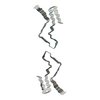
|
|---|---|
| 1 |
|
- Components
Components
| #1: Protein | Mass: 22996.355 Da / Num. of mol.: 10 Source method: isolated from a genetically manipulated source Source: (gene. exp.)  Homo sapiens (human) / Gene: PRNP, ALTPRP, PRIP, PRP / Production host: Homo sapiens (human) / Gene: PRNP, ALTPRP, PRIP, PRP / Production host:  Has protein modification | Y | Sequence details | Regarding the conflict, the Met residue is a part of the initiation codon of human prion protein ...Regarding the conflict, the Met residue is a part of the initiation codon of human prion protein (PrP) in prokaryotic expression system. (see SEQADV) | |
|---|
-Experimental details
-Experiment
| Experiment | Method: ELECTRON MICROSCOPY |
|---|---|
| EM experiment | Aggregation state: HELICAL ARRAY / 3D reconstruction method: helical reconstruction |
- Sample preparation
Sample preparation
| Component | Name: human prion protein amyloid fibril / Type: ORGANELLE OR CELLULAR COMPONENT / Entity ID: all / Source: RECOMBINANT |
|---|---|
| Source (natural) | Organism:  Homo sapiens (human) Homo sapiens (human) |
| Source (recombinant) | Organism:  |
| Buffer solution | pH: 5 |
| Specimen | Embedding applied: NO / Shadowing applied: NO / Staining applied: NO / Vitrification applied: YES |
| Vitrification | Cryogen name: ETHANE |
- Electron microscopy imaging
Electron microscopy imaging
| Experimental equipment |  Model: Titan Krios / Image courtesy: FEI Company |
|---|---|
| Microscopy | Model: FEI TITAN KRIOS |
| Electron gun | Electron source:  FIELD EMISSION GUN / Accelerating voltage: 300 kV / Illumination mode: FLOOD BEAM FIELD EMISSION GUN / Accelerating voltage: 300 kV / Illumination mode: FLOOD BEAM |
| Electron lens | Mode: BRIGHT FIELD |
| Image recording | Electron dose: 64 e/Å2 / Film or detector model: GATAN K2 QUANTUM (4k x 4k) |
- Processing
Processing
| CTF correction | Type: NONE |
|---|---|
| Helical symmerty | Angular rotation/subunit: 179.449 ° / Axial rise/subunit: 2.403 Å / Axial symmetry: C1 |
| 3D reconstruction | Resolution: 2.702 Å / Resolution method: FSC 0.143 CUT-OFF / Num. of particles: 86012 / Symmetry type: HELICAL |
 Movie
Movie Controller
Controller




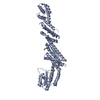
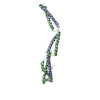


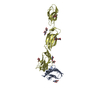
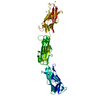
 PDBj
PDBj


